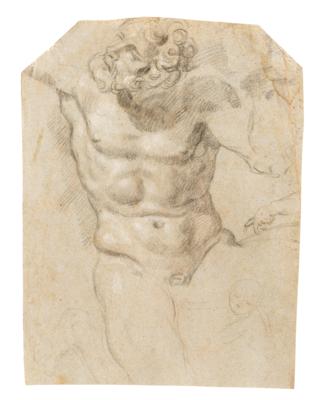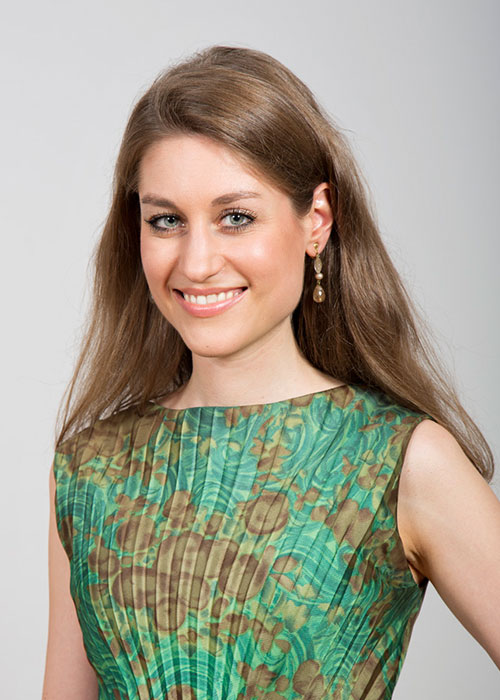Annibale Carracci

(Bologna 1560-1609 Rome)
A study of Atlas Farnese, black and white chalk, on greyish laid paper, Drapery studies in red chalk on the reverse, 34,5 x 26,5 cm, mounted, unframed, (Sch)
Provenance:
Private collection, Italy.
A certificate by Prof. Daniele Benati, 23rd December 2020 (in copy) is available.
The present study is an important addition to the Corpus of the drawings of Annibale Carracci with studies after antiquity, which the artist made after his move from Bologna to Rome at the end of 1595 (see: A. Weston Lewis, „Annibale Carracci and the Antique“, in: Master Drawings, 30, 1992, pp. 287-213).
The purpose of his journey was to decorate the Sala Grande in the Palazzo Farnese which Annibale’s new patron and client Cardinal Odoardo Farnese wanted to dedicate to the deeds of Alexander III Farnese as commander of the troops of Philip II in the Netherlands. Due to the ongoing indecision of Odoardo, who finally assigned to Annibale the decoration of the Camerino and the gallery in the palazzo, which was to house the Farnesine collection of ancient statues, the sojourn in Rome initially offered Annibale the possibility to study the Roman works of Michelangleo and Raphael and to focus his attention to the remains of classical antiquity, the study of which was an important basis for his later artistic activity.
The present study adds to the already well known drawings of the artist after antiquity dedicated to Pan and Daphne and to the group of Niobe. Our sheet goes back to the sculpture of the Atlas Farnese, which was then part of the Farnesine collections; today it is preserved in the Museo Archeologico Nazionale in Naples (Inv. 6374). The sculpture represents the demigod Atlas, who is holding the celestial sphere on his shoulders as punishment for his support of the Titans in their attempt to rise against Zeus. The massive marble statue which presumably is a copy after a Greek original sculpture from the 2nd century before Christ, was found damaged at head and the limbs at the end of the 14th century and subsequently owned by Stefano del Bufalo. After an extensive restoration by Guglielmo della Porta the sculpture was acquired by Cardinal Alessandro Farnese for the huge sum of 250 scudi in 1562. In 1787 it was transferred to Naples together with the collections issued by Charles III. of Bourbon, who was the son of Elisabetta Farnese and last descendant of the distinguished family.
As in the case of the head study of Pan (Louvre, Département des Arts Graphiques, Inv. 7193) it is likely, that Annibale copied the sculpture of Atlas in order to appropriate the depiction of the human figure according to the model of classical antiquity without initially having had a particular use of the study in mind. Perhaps he was aware of the additions of Guglielmo della Porta and therefore concentrated more on the torso of the sculpture whereas he treated the restored parts of the head and the limbs only summarily. As he did with the head of Pan in the Louvre, which the artist used for his painting Pan and Diana in the vaults of the Farnese gallery, he may have harked back to the previously studied model of Atlas who is supporting the celestial sphere when he painted the figure of Hercules in the vaults of the Camerino. Even if the pose is reminiscent of the Atlas Farnese, Annibale’s chosen solution appears to be very different both in the fresco and in the known preliminary drawings. (See the prlimimnarys studies for the fresco with Hercules in: Oxford, Ashmolean Museum, Torino, Biblioteca Reale, Inv. 16074; Paris, Louvre, Départment des Arts Graphiques, Inv. 7205, 7206; Besancon, Musée des Beaux-Arts, Inv. D. 1539; J. R. Martin, The Farnese Gallery, Princeton 1965, p. 240, 242-243, Figs. 100-101, 113-117). Annibale’s drawings after antiquity may have therefore primarily served as a repertoire for ideas and artistic solutions that he later could draw on. The studies of drapery sketched in red chalk on the reverse which are not related to any known work, remind of Annibale’s working procedure of turning the sheet upside down and rotating it several times while drawing.
The present drawing with the study of Atlas Farnese is hence an important addition to the graphic work of Annibale Carracci and his studies after antiquity. It can be dated stylistically between 1596-1598, when the artist was in Rome in order to decorate the Sala Grande of the Palazzo Farnese.
We are grateful to Prof. Daniele Benati for confirming the attribution and for the scientific support.
Esperta: Mag. Astrid-Christina Schierz
 Mag. Astrid-Christina Schierz
Mag. Astrid-Christina Schierz
+43-1-515 60-546
astrid.schierz@dorotheum.at
04.04.2023 - 14:00
- Stima:
-
EUR 25.000,- a EUR 35.000,-
- Prezzo di partenza:
-
EUR 18.000,-
Annibale Carracci
(Bologna 1560-1609 Rome)
A study of Atlas Farnese, black and white chalk, on greyish laid paper, Drapery studies in red chalk on the reverse, 34,5 x 26,5 cm, mounted, unframed, (Sch)
Provenance:
Private collection, Italy.
A certificate by Prof. Daniele Benati, 23rd December 2020 (in copy) is available.
The present study is an important addition to the Corpus of the drawings of Annibale Carracci with studies after antiquity, which the artist made after his move from Bologna to Rome at the end of 1595 (see: A. Weston Lewis, „Annibale Carracci and the Antique“, in: Master Drawings, 30, 1992, pp. 287-213).
The purpose of his journey was to decorate the Sala Grande in the Palazzo Farnese which Annibale’s new patron and client Cardinal Odoardo Farnese wanted to dedicate to the deeds of Alexander III Farnese as commander of the troops of Philip II in the Netherlands. Due to the ongoing indecision of Odoardo, who finally assigned to Annibale the decoration of the Camerino and the gallery in the palazzo, which was to house the Farnesine collection of ancient statues, the sojourn in Rome initially offered Annibale the possibility to study the Roman works of Michelangleo and Raphael and to focus his attention to the remains of classical antiquity, the study of which was an important basis for his later artistic activity.
The present study adds to the already well known drawings of the artist after antiquity dedicated to Pan and Daphne and to the group of Niobe. Our sheet goes back to the sculpture of the Atlas Farnese, which was then part of the Farnesine collections; today it is preserved in the Museo Archeologico Nazionale in Naples (Inv. 6374). The sculpture represents the demigod Atlas, who is holding the celestial sphere on his shoulders as punishment for his support of the Titans in their attempt to rise against Zeus. The massive marble statue which presumably is a copy after a Greek original sculpture from the 2nd century before Christ, was found damaged at head and the limbs at the end of the 14th century and subsequently owned by Stefano del Bufalo. After an extensive restoration by Guglielmo della Porta the sculpture was acquired by Cardinal Alessandro Farnese for the huge sum of 250 scudi in 1562. In 1787 it was transferred to Naples together with the collections issued by Charles III. of Bourbon, who was the son of Elisabetta Farnese and last descendant of the distinguished family.
As in the case of the head study of Pan (Louvre, Département des Arts Graphiques, Inv. 7193) it is likely, that Annibale copied the sculpture of Atlas in order to appropriate the depiction of the human figure according to the model of classical antiquity without initially having had a particular use of the study in mind. Perhaps he was aware of the additions of Guglielmo della Porta and therefore concentrated more on the torso of the sculpture whereas he treated the restored parts of the head and the limbs only summarily. As he did with the head of Pan in the Louvre, which the artist used for his painting Pan and Diana in the vaults of the Farnese gallery, he may have harked back to the previously studied model of Atlas who is supporting the celestial sphere when he painted the figure of Hercules in the vaults of the Camerino. Even if the pose is reminiscent of the Atlas Farnese, Annibale’s chosen solution appears to be very different both in the fresco and in the known preliminary drawings. (See the prlimimnarys studies for the fresco with Hercules in: Oxford, Ashmolean Museum, Torino, Biblioteca Reale, Inv. 16074; Paris, Louvre, Départment des Arts Graphiques, Inv. 7205, 7206; Besancon, Musée des Beaux-Arts, Inv. D. 1539; J. R. Martin, The Farnese Gallery, Princeton 1965, p. 240, 242-243, Figs. 100-101, 113-117). Annibale’s drawings after antiquity may have therefore primarily served as a repertoire for ideas and artistic solutions that he later could draw on. The studies of drapery sketched in red chalk on the reverse which are not related to any known work, remind of Annibale’s working procedure of turning the sheet upside down and rotating it several times while drawing.
The present drawing with the study of Atlas Farnese is hence an important addition to the graphic work of Annibale Carracci and his studies after antiquity. It can be dated stylistically between 1596-1598, when the artist was in Rome in order to decorate the Sala Grande of the Palazzo Farnese.
We are grateful to Prof. Daniele Benati for confirming the attribution and for the scientific support.
Esperta: Mag. Astrid-Christina Schierz
 Mag. Astrid-Christina Schierz
Mag. Astrid-Christina Schierz
+43-1-515 60-546
astrid.schierz@dorotheum.at
|
Hotline dell'acquirente
lun-ven: 10.00 - 17.00
kundendienst@dorotheum.at +43 1 515 60 200 |
| Asta: | Disegni e stampe d'autore fino al 1900 |
| Tipo d'asta: | Asta online |
| Data: | 04.04.2023 - 14:00 |
| Luogo dell'asta: | Wien | Palais Dorotheum |
| Esposizione: | 29.03. - 04.04.2023 |
